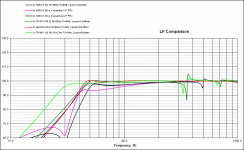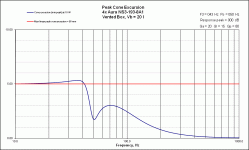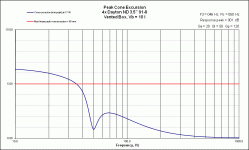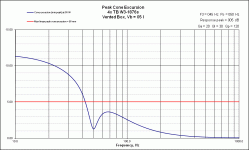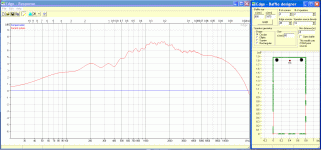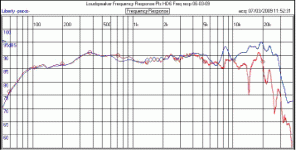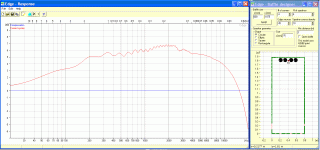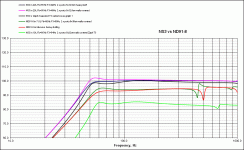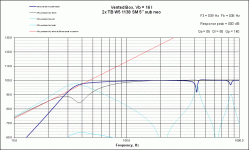If I went down the down firing woofer route (assuming that it is possible):
What clearance would be needed below the cabinet?
What would be the minimum recommended clearance behind the magnet?
Would the crossover point need to be lowered from 200 Hz?
Thank you everyone for your input.
What clearance would be needed below the cabinet?
What would be the minimum recommended clearance behind the magnet?
Would the crossover point need to be lowered from 200 Hz?
Thank you everyone for your input.
Last edited:
I don't think down firing is a great idea. You are going to need at least an inch of clearance and I think the upper end of the bandwidth might be spoilt.
I do think you need to use a reflex design here, whether that be a port or a PR. And I don't think either way is more or less prone to mistakes, both have their foibles in equal measure.
I think this has the potential to be a great performer, certainly a Bose beater if a bit of response shaping was employed
I do think you need to use a reflex design here, whether that be a port or a PR. And I don't think either way is more or less prone to mistakes, both have their foibles in equal measure.
I think this has the potential to be a great performer, certainly a Bose beater if a bit of response shaping was employed
Last edited:
Thanks richie00boy. I had thought that the 100-200Hz bandwidth might be less than ideal with down-firing.
If PR and ported are just as tricky to tune, then I may as well go ported.
Could you describe the different results with ported and sealed? I am still leaning towards 4x 3" drivers. Aurasound or Tang Bands.
If PR and ported are just as tricky to tune, then I may as well go ported.
Could you describe the different results with ported and sealed? I am still leaning towards 4x 3" drivers. Aurasound or Tang Bands.
Sealed will simply not go as deep. I think to get the most out of the system it should be ported, as I believe that any standalone speaker should get down to at least 100Hz. Have to see what the volume requirements work out to though, it may be too difficult to fit a port in.
Tangband frequency response: http://www.tb-speaker.com/detail/1230_04/w3-1876s.htm
Aurasound frequency response: The Madisound Speaker Store
The Tang Band frequency response looks flat (ish) between 50 and 200hz. Do the manufacturers use ported enclosures to make these measurements?
I'm sorry- but this indeed incorrect. Aura does not make the ND drivers. They are a copy, and are made in a totally different build house.
The tech is similar, but maybe not identical.
Hard to believe, Aura pulled out of the retail market to do OEM drivers for others and their tech is patented.
dave
Well, I just took my little box with 2 of the ND91-8's and set it up downfiring about 1" above a flat surface and that's with the drivers and the ports facing downward. Certainly I lost a whole bunch of high frequencies but the bass, drums and guitar were still coming through quite nicely 6ft away. So in other words, I thought below 200Hz was just fine. For your purposes, meaning background listening in the kitchen, I still think it could work nicely if you have enough space to fit about 150mm. The W5 is 80mm deep in the cab, 19mm thick walls adds 38mm and 25mm above the fridge leaves you with 7mm behind the magnet. So box height would be 125mm. Or you could go with thinner walls, like 13mm. Notice that with most drivers, sound is escaping sideways from the driver frame anyways so I think you'll be all right without too much space behind the driver.
But there is certainly a nice aesthetic to a bunch of small drivers all lined up on a narrow baffle. I've got the feeling that you aren't using a box modelling program yet so below is a comparison of all 4 drivers mentioned so far and their low frequency responses. The W5 will definitely go lower than the rest. All of the 3 inchers (all modelled with 4 drivers series/parallel) give a reasonably similar response up to about 100dB at 1m but box size, cone excursion, port lengths and port resonances are the things that are going to vary the most between them. Considering the different prices and that you don't really have box volume limitations, my choice would be the NS3 - shortest ports, least port resonances and flattest output within xmax limitations. Worst performance btw is with 4 of the Peerless PR's instead of ports.
Graphs 2, 3 and 4 show the cone excursion for each of the 3 inchers (again this is with 4 of them) at 100dB 1m. Again not a lot of difference between the Aura and the Dayton but the TB excursion sky-rockets with material below 40Hz. Granted, most musical content is above 40Hz but certainly not all of it. And all drivers stay below mechanical limits anyways and 100dB is probably louder than you're ever going to need.
All sims are based on manufacturers' specs so reality may be a touch different. And of course, other alignments and results are possible too.
One other thing I was going to mention is that the best thing you can probably do is have the baffle fill in all the available space between the fridge and the cupboards and walls etc. If you can get all the front surfaces flush then you'll have no baffle diffraction effects to worry about. This can make a difference when you're not using any xo's or contouring filters.
But there is certainly a nice aesthetic to a bunch of small drivers all lined up on a narrow baffle. I've got the feeling that you aren't using a box modelling program yet so below is a comparison of all 4 drivers mentioned so far and their low frequency responses. The W5 will definitely go lower than the rest. All of the 3 inchers (all modelled with 4 drivers series/parallel) give a reasonably similar response up to about 100dB at 1m but box size, cone excursion, port lengths and port resonances are the things that are going to vary the most between them. Considering the different prices and that you don't really have box volume limitations, my choice would be the NS3 - shortest ports, least port resonances and flattest output within xmax limitations. Worst performance btw is with 4 of the Peerless PR's instead of ports.
Graphs 2, 3 and 4 show the cone excursion for each of the 3 inchers (again this is with 4 of them) at 100dB 1m. Again not a lot of difference between the Aura and the Dayton but the TB excursion sky-rockets with material below 40Hz. Granted, most musical content is above 40Hz but certainly not all of it. And all drivers stay below mechanical limits anyways and 100dB is probably louder than you're ever going to need.
All sims are based on manufacturers' specs so reality may be a touch different. And of course, other alignments and results are possible too.
One other thing I was going to mention is that the best thing you can probably do is have the baffle fill in all the available space between the fridge and the cupboards and walls etc. If you can get all the front surfaces flush then you'll have no baffle diffraction effects to worry about. This can make a difference when you're not using any xo's or contouring filters.
Attachments
...below is a comparison of all 4 drivers mentioned so far and their low frequency responses.
Except for the green curve (and for it, we hope for some room gain), none of those alignments are particularily nice.
dave
Hard to believe, Aura pulled out of the retail market to do OEM drivers for others and their tech is patented.
dave
PE calls them 'Neo-balanced', and 'Neo-Radial' is Aura's patented term.
If PE was using the tech and building them at Aura (which they are not) they would likely be under contract to state that they are.
Again- not made by Aura.
Later,
Wolf
jReave: Thank you so much for your help so far.
I am going to ditch the PRs.
I am going to ditch the down-firing idea, as I will not save enough front baffle depth to make it worthwhile.
I am going to ditch the Tang Bands 3" too.
The Dayton, and the Aurosound model very similarly, but the NS3 seems to be smoother.
So we are left with 2x TangBand 5.25", or 4x Aurosound NS3.
The slim front baffle greatly appeals, as you suspected. I am going to put together some cardboard mock-ups to see whether a 16cm baffle looks way too big.
Are you talking about BSC? I had forgotten about this. The unit will be in free air on three sides (all except for below). One solution would be to put a second pair of Jordans on the rear of the cabinet, but they would end up a maximum of 10cm from the back wall. Too close? Lots of reflections.
I am going to ditch the PRs.
I am going to ditch the down-firing idea, as I will not save enough front baffle depth to make it worthwhile.
I am going to ditch the Tang Bands 3" too.
The Dayton, and the Aurosound model very similarly, but the NS3 seems to be smoother.
So we are left with 2x TangBand 5.25", or 4x Aurosound NS3.
The slim front baffle greatly appeals, as you suspected. I am going to put together some cardboard mock-ups to see whether a 16cm baffle looks way too big.
One other thing I was going to mention is that the best thing you can probably do is have the baffle fill in all the available space between the fridge and the cupboards and walls etc. If you can get all the front surfaces flush then you'll have no baffle diffraction effects to worry about. This can make a difference when you're not using any xo's or contouring filters.
Are you talking about BSC? I had forgotten about this. The unit will be in free air on three sides (all except for below). One solution would be to put a second pair of Jordans on the rear of the cabinet, but they would end up a maximum of 10cm from the back wall. Too close? Lots of reflections.
Good to hear your experiences.
It seems that you used the same box volume for all those simulations?
Not at all. Look closer.
Except for the green curve (and for it, we hope for some room gain), none of those alignments are particularily nice.
dave
Agreed. I was just trying to compare how low each of them would reasonably go.
Seems the modelled alignments deliberately favour your suggested driver. Poor show
Au contraire. Originally I favored the ND91-8 (that's what I'm using) but think the W5 would be the best choice. But for a 3 incher I finished by recommending the Aura.
Are you talking about BSC? I had forgotten about this. The unit will be in free air on three sides (all except for below). One solution would be to put a second pair of Jordans on the rear of the cabinet, but they would end up a maximum of 10cm from the back wall. Too close? Lots of reflections.
Baffle diffraction and baffle step loss. First graph below shows the diffraction of the 2 Jordans on a baffle on top of a fridge. In effect the baffle and fridge create 1 big baffle surface so diffraction effects are minimal but baffle step loss still occurs, albeit at a low frequency - you are starting to lose SPL at around 500-600Hz. The little bit of diffraction boost that you get between 900 and 2500Hz will actually help to fill in the small dip in that area on the Jordans (Jordon FR, 2nd graph) so that should work out well but you may need to move the xo up 300Hz or 360Hz to match the baffle step loss on the Jordans.
The 3rd graph shows the baffle effects for 4 x the 3 inchers and here you can see that you start to lose bass right around where you want to cross it over. That you are going to have to do something about but I think your amp should be able to fix that pretty well since it's got 3 bass boosts to choose from for the sub out. On 1 of my amps, my bass control gives me a 6dB boost starting at about 500Hz, so if 1 of those 3 is similar that will effectively counteract your baffle step loss. Hopefully.
Simulations are with The Edge. Very easy and quick to figure out and to use: Tolvan Data
Attachments
jReave: Thanks again for your input.
Over the weekend, I made two mock-ups, and I have decided to stick with my original idea of 4x 3" units. It was a close call between 2x Tangband 5.25", but I am really looking for small form factor.
The next issue is cabinet volume.
jReave: Is there any reason why you chose 20L for the Aurasound NS3, and 10L for the Dayton ND91 in post No. 28?
Circa 10L would suit my design better.
Over the weekend, I made two mock-ups, and I have decided to stick with my original idea of 4x 3" units. It was a close call between 2x Tangband 5.25", but I am really looking for small form factor.
The next issue is cabinet volume.
jReave: Is there any reason why you chose 20L for the Aurasound NS3, and 10L for the Dayton ND91 in post No. 28?
Circa 10L would suit my design better.
It's a driver's TS parameters that determine what size box it's going to like and how low it's going to go in it and how loud it can go there, etc, etc. In the case of the ND91's, it appears as though they have been designed with the specific intent of working in very small boxes - but the trade-off is that they require longer ports so that adds a little volume back to the box in the end.
But you can play around with these relationships. If you want to use a smaller box, you need to either raise the tuning frequency, Fb, or increase the length of the port to keep Fb the same. If you want to lower the box tuning then you either need a bigger box or a longer port but either 1 of those can mean that the response starts to peak (possibly boomy in other words) around Fb, in which case some extra stuffing may need to be used to help tame the peak. On the other hand, letting the response peak at around 60Hz by a couple of dB is a well known 'trick' that can give the illusion of more bass than is actually being produced.
Below are some more comparisons of the NS3 and the ND91-8 to give you more info. Each case is with 4 drivers series/parallel. This time, I'm trying to get the best response I can out of them. To confuse things just a bit more for you, sometimes (well ok, frequently) manufacturers' specs can be a little off from reality so it can help to use someone else's measurements for a more accurate simulation. Zaph has done that with the NS3 and I show the comparison below. Dayton is generally fairly accurate and I'm using their specs here but these might be just a touch off as well. In the end, you might have to fine tune the port for a result that is most pleasing to your ears.
So, the Aura likes a bigger box but can play lower. If you use a smaller box, the F3 has to go up as you can see in the final graph. The ND91-8 likes a smaller box, but the tuning is also a little higher and it needs longer ports. You can see that going with less stuffing gives you the peaking I was talking about. Driver levels btw are adjusted just for the sake of clarity.
If you have some time and want to learn this stuff for yourself, you can use one of the following freeware programs:
Unibox (needs Excel) - UniBox - Unified Box Model for Loudspeaker Design
WinISD - LinearTeam
Back in your 1st post you mentioned 80cm wide x 80cm deep might be ok. That gives you a lot of volume to work with but I'm sure you have a reason now for wanting something closer to 10L. Notice that with the Daytons and the small depth of the cab that you may need to side vent them or use right angled ports because of their 38cm length.
But you can play around with these relationships. If you want to use a smaller box, you need to either raise the tuning frequency, Fb, or increase the length of the port to keep Fb the same. If you want to lower the box tuning then you either need a bigger box or a longer port but either 1 of those can mean that the response starts to peak (possibly boomy in other words) around Fb, in which case some extra stuffing may need to be used to help tame the peak. On the other hand, letting the response peak at around 60Hz by a couple of dB is a well known 'trick' that can give the illusion of more bass than is actually being produced.
Below are some more comparisons of the NS3 and the ND91-8 to give you more info. Each case is with 4 drivers series/parallel. This time, I'm trying to get the best response I can out of them. To confuse things just a bit more for you, sometimes (well ok, frequently) manufacturers' specs can be a little off from reality so it can help to use someone else's measurements for a more accurate simulation. Zaph has done that with the NS3 and I show the comparison below. Dayton is generally fairly accurate and I'm using their specs here but these might be just a touch off as well. In the end, you might have to fine tune the port for a result that is most pleasing to your ears.
So, the Aura likes a bigger box but can play lower. If you use a smaller box, the F3 has to go up as you can see in the final graph. The ND91-8 likes a smaller box, but the tuning is also a little higher and it needs longer ports. You can see that going with less stuffing gives you the peaking I was talking about. Driver levels btw are adjusted just for the sake of clarity.
If you have some time and want to learn this stuff for yourself, you can use one of the following freeware programs:
Unibox (needs Excel) - UniBox - Unified Box Model for Loudspeaker Design
WinISD - LinearTeam
Back in your 1st post you mentioned 80cm wide x 80cm deep might be ok. That gives you a lot of volume to work with but I'm sure you have a reason now for wanting something closer to 10L. Notice that with the Daytons and the small depth of the cab that you may need to side vent them or use right angled ports because of their 38cm length.
Attachments
Well, just over a year later, I am finally about to start this build. Too many other commitments.
I have bought all the components, and have changed the design a little.
The box will now be 90cm wide, and 21cm high, and deep. I will be using 19mm ply in a translaminated build.
This extra space on the front baffle has allowed me to go for the Tang Band W5-1138, and I will be using two of them. As my design stands, the cabinet for the woofers will be 16.7 litres. http://www.tb-speaker.com/detail/1208_03/w5-1138sm.htm
I would like some help in tuning the enclosure (vented). I would possibly prefer to do a slot loaded design, and this would be simple with a translam build.
What dimensions should I make my vent? The maximum width can be 54cm. Height needs to be in multiples of 18mm. Length can be up to 10cm or so. N.B some volume will be used up by the vent.
Thanks in advance.
I have bought all the components, and have changed the design a little.
The box will now be 90cm wide, and 21cm high, and deep. I will be using 19mm ply in a translaminated build.
This extra space on the front baffle has allowed me to go for the Tang Band W5-1138, and I will be using two of them. As my design stands, the cabinet for the woofers will be 16.7 litres. http://www.tb-speaker.com/detail/1208_03/w5-1138sm.htm
I would like some help in tuning the enclosure (vented). I would possibly prefer to do a slot loaded design, and this would be simple with a translam build.
What dimensions should I make my vent? The maximum width can be 54cm. Height needs to be in multiples of 18mm. Length can be up to 10cm or so. N.B some volume will be used up by the vent.
Thanks in advance.
Well, below is what 2 x W5's look like in 16L net using Unibox. The box is tuned to 38Hz giving you an F3 of about 39Hz. Rolloff starts at about 90Hz, somewhere near where room gain starts to increase the response, although I don't know what that will be like exactly in your room.
This is with 2 ports that are 40cm long and have an internal diameter of 5cm. That will allow you about 150W without exceeding xmax above about 34Hz and put you righ close to exceeding the recommended port air speed. With a slot port, the length and cross-sectional area need to stay the same.
So, it looks like you need to reconsider how long your port(s) can be - you probably need to put a right angle in it. Also if you want to go with one or 2 ports. Port length can be diminished if you go with a narrower port, but that means potential port noise can happen at lower SPL's. So you may also want to decide on maximum SPL's in order to determine port diameter and therefore length.
This is with 2 ports that are 40cm long and have an internal diameter of 5cm. That will allow you about 150W without exceeding xmax above about 34Hz and put you righ close to exceeding the recommended port air speed. With a slot port, the length and cross-sectional area need to stay the same.
So, it looks like you need to reconsider how long your port(s) can be - you probably need to put a right angle in it. Also if you want to go with one or 2 ports. Port length can be diminished if you go with a narrower port, but that means potential port noise can happen at lower SPL's. So you may also want to decide on maximum SPL's in order to determine port diameter and therefore length.
Attachments
Thanks jReave.
I am using winISD. I can't seem to get to grips with Unibox.
If I use 1 port only, then this one should be about perfect 40mm x 135mm. My cabinet will accommodate it nicely, and it has flared ends.
40mm Flanged Port
Please could you confirm that this would be suitable?
Thanks
I am using winISD. I can't seem to get to grips with Unibox.
If I use 1 port only, then this one should be about perfect 40mm x 135mm. My cabinet will accommodate it nicely, and it has flared ends.
40mm Flanged Port
Please could you confirm that this would be suitable?
Thanks
- Status
- This old topic is closed. If you want to reopen this topic, contact a moderator using the "Report Post" button.
- Home
- Loudspeakers
- Multi-Way
- Please help to choose a small 3" woofer
